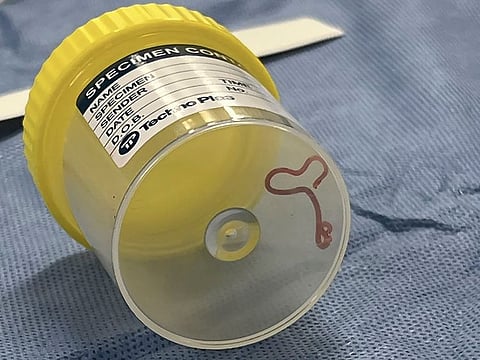Australian doctors find live parasitic worm in woman's brain
The 8cm roundworm is a common parasite in kangaroos and carpet pythons - but not in humans

Sydney: A parasitic roundworm typically found in snakes has been pulled "alive and wriggling" from a woman's brain in a stomach-churning medical first, Australian doctors said Tuesday.
Baffled doctors performed an MRI scan on the 64-year-old Australian woman after she began suffering memory lapses, noticing an "atypical lesion" at the front of her brain.
It was an eight-centimetre (three-inch) roundworm, called Ophidascaris robertsi, which researchers said was a common parasite in kangaroos and carpet pythons - but not humans.
Surgeon Hari Priya Bandi was performing a biopsy through a hole in the patient’s skull at Canberra Hospital last year when she used forceps to pull out the parasite, which measured 8 centimeters, or 3 inches.
"I just thought: ‘What is that? It doesn’t make any sense. But it’s alive and moving,’” Bandi was quoted Tuesday in The Canberra Times newspaper.
“It continued to move with vigor. We all felt a bit sick,” Bandi added of her operating team.
Bandi and Canberra infectious diseases physician Sanjaya Senanayake are authors of an article about the extraordinary medical case published in the latest edition of the journal Emerging Infectious Diseases.
Senanayake said he was on duty at the hospital in June last year when the worm was found.
"This is the first-ever human case of Ophidascaris to be described in the world," said infectious disease expert Sanjaya Senanayake.
"To our knowledge, this is also the first case to involve the brain of any mammalian species, human or otherwise."
The parasite, which appeared as a "stringlike structure" on brain scans, was then identified through DNA testing.
"It is never easy or desirable to be the first patient in the world for anything," Senanayake said.
"I can't state enough our admiration for this woman, who has shown patience and courage through this process."
The woman had been admitted to the hospital after experiencing forgetfulness and worsening depression over three months. Scans showed changes in her brain.
A year earlier, she had been admitted to her local hospital in southeast New South Wales state with symptoms including abdominal pain, diarrhea, a dry cough and night sweats.
Senanayake said the brain biopsy was expected to reveal a cancer or an abscess.
“This patient had been treated ... for what was a mystery illness that we thought ultimately was a immunological condition because we hadn’t been able to find a parasite before and then out of nowhere, this big lump appeared in the frontal part of her brain,” Senanayake said.
“Suddenly, with her (Bandi’s) forceps, she’s picking up this thing that’s wriggling. She and everyone in that operating theater were absolutely stunned,” Senanayake added.
Researchers believe the woman was infected after foraging for edible shrubs near her house, which were likely contaminated with parasitic larvae shed in snake faeces.
Senanayake said Ophidascaris roundworms were known to infect animals in other parts of the world, and it was "likely that other cases will be recognised in coming years".
Sign up for the Daily Briefing
Get the latest news and updates straight to your inbox





